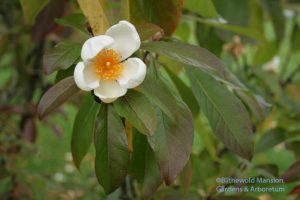I brake for Franklinia alatamaha
 Sometimes it’s all about timing. John and William Bartram were in exactly the right place, the coastal shores of the Altamaha River in Georgia, at exactly the right time, 1770, just a few years before the tree they discovered there became extinct. They collected seeds, propagated a few plants and named it Franklinia alatamaha for their friend Benjamin Franklin and the site of discovery (a variant spelling of the river – or was it dyslexia?). And even though they and other plant hunters kept searching for the tree, it was considered extinct in the wild within 30 years of its discovery. All of the Franklin trees in cultivation today are descendants of the Bartram’s original collection. Although enthusiastic collection may have contributed to the tree’s early disappearance, it was on its way out already due to a rapidly changing environment.
Sometimes it’s all about timing. John and William Bartram were in exactly the right place, the coastal shores of the Altamaha River in Georgia, at exactly the right time, 1770, just a few years before the tree they discovered there became extinct. They collected seeds, propagated a few plants and named it Franklinia alatamaha for their friend Benjamin Franklin and the site of discovery (a variant spelling of the river – or was it dyslexia?). And even though they and other plant hunters kept searching for the tree, it was considered extinct in the wild within 30 years of its discovery. All of the Franklin trees in cultivation today are descendants of the Bartram’s original collection. Although enthusiastic collection may have contributed to the tree’s early disappearance, it was on its way out already due to a rapidly changing environment.  (Sound familiar? Let it be a lesson.) Perhaps if the cultivation of cotton in the area hadn’t spread a debilitating root pathogen, it might have been able to crawl back by layered limbs to cooler climbs where it seems happier today. Franklinia is listed as hardy in USDA zones 5 to 8(9) and has Goldilock’s cultural requirements: Full sun to light shade; rich, acidic and moist but well drained soil; not too dry, not too wet – juuust right. But we easily forgive its persnickety-ness and even give it pride of place because it has the extra-special distinction of extinction.
(Sound familiar? Let it be a lesson.) Perhaps if the cultivation of cotton in the area hadn’t spread a debilitating root pathogen, it might have been able to crawl back by layered limbs to cooler climbs where it seems happier today. Franklinia is listed as hardy in USDA zones 5 to 8(9) and has Goldilock’s cultural requirements: Full sun to light shade; rich, acidic and moist but well drained soil; not too dry, not too wet – juuust right. But we easily forgive its persnickety-ness and even give it pride of place because it has the extra-special distinction of extinction.
Timing is everything. Although our Franklinia (a sizable well-established specimen planted in 1969) usually begins blooming in August, it was never ever more beautiful than it is right now. A delayed frost has the flowers continuing to open bright creamy-white against a frame of brilliant reddening fall foliage. Dirr says, “it is best not to become smitten with this plant.” Too late. I brake for Franklinia alatamaha – do you?

